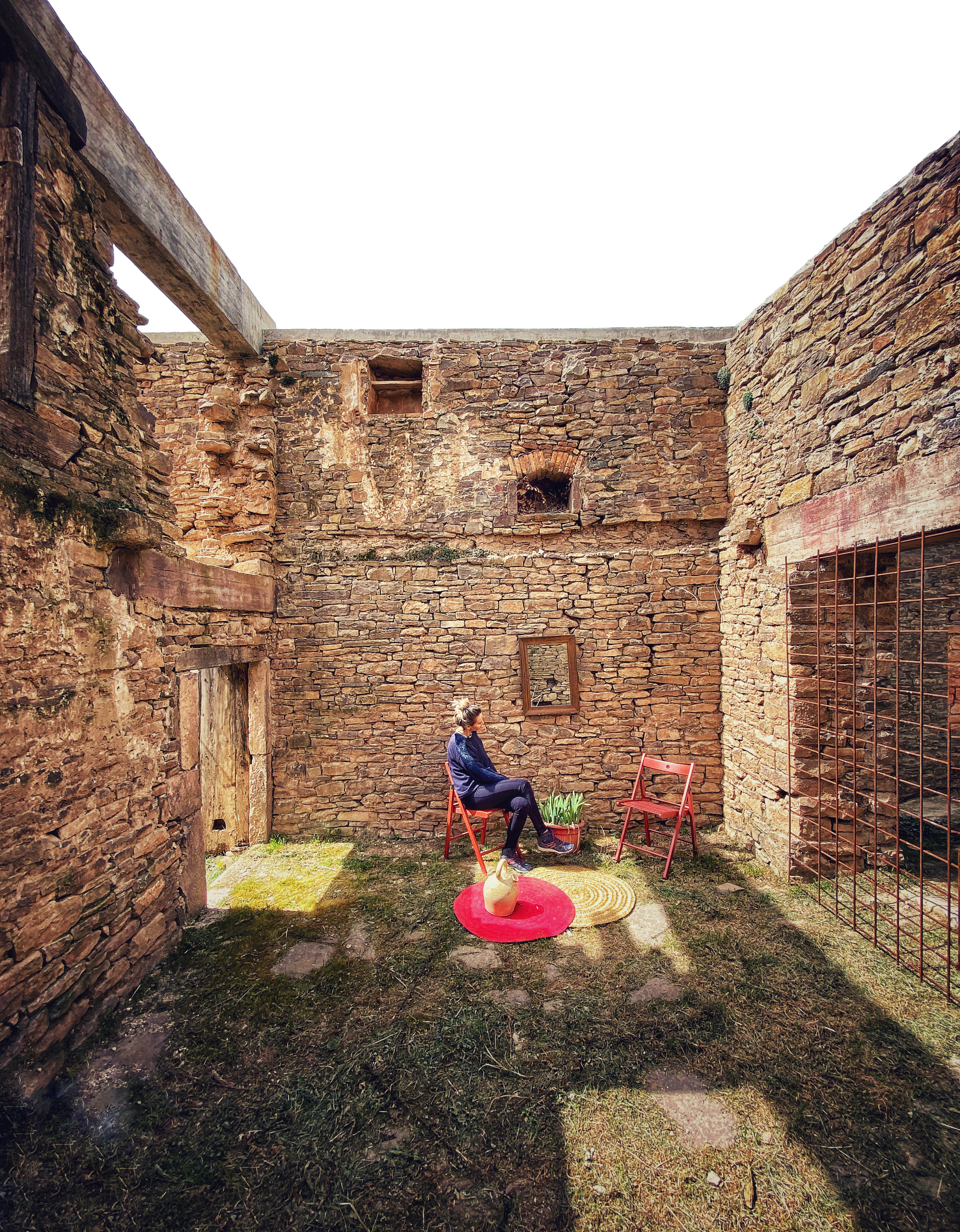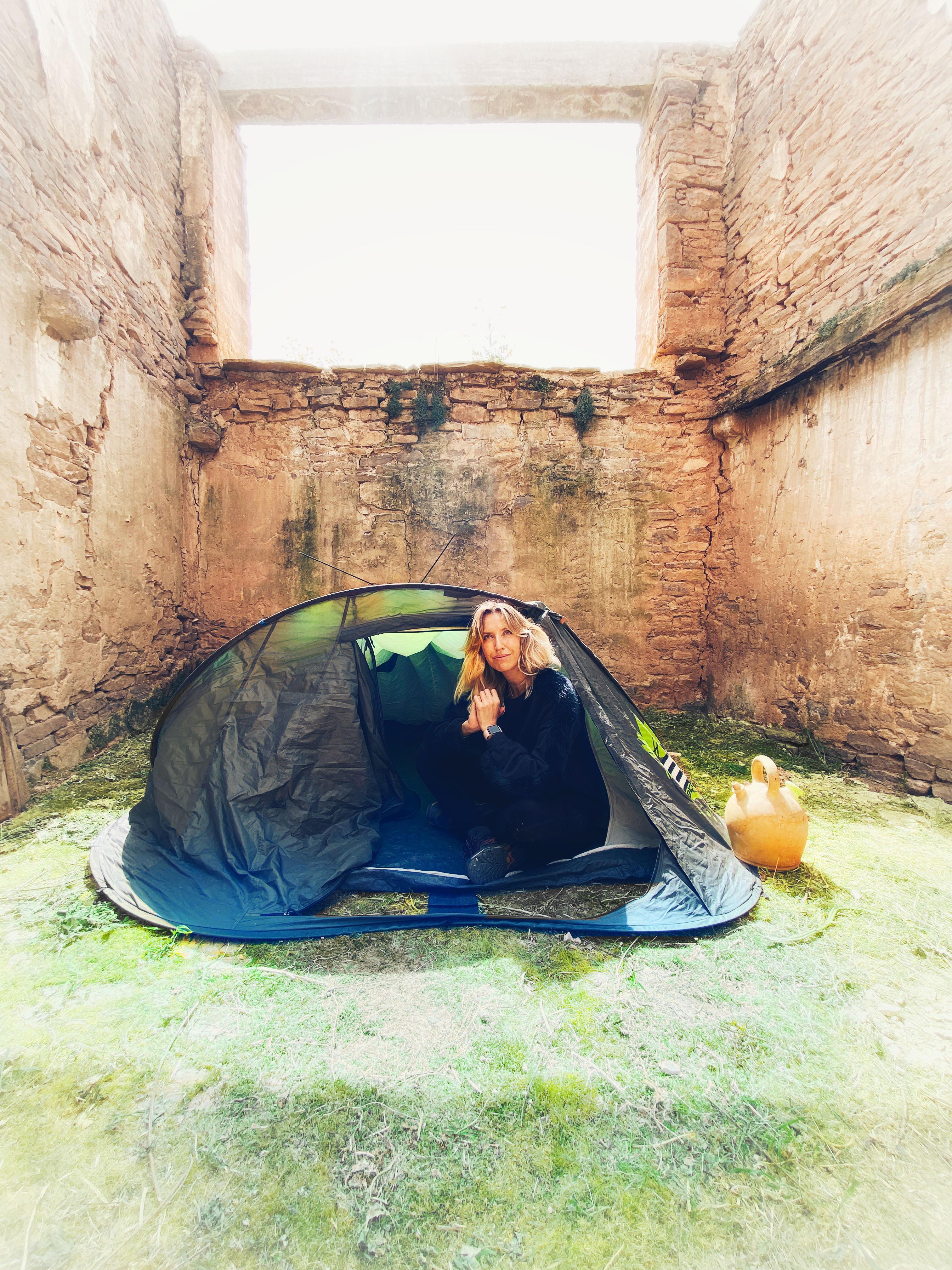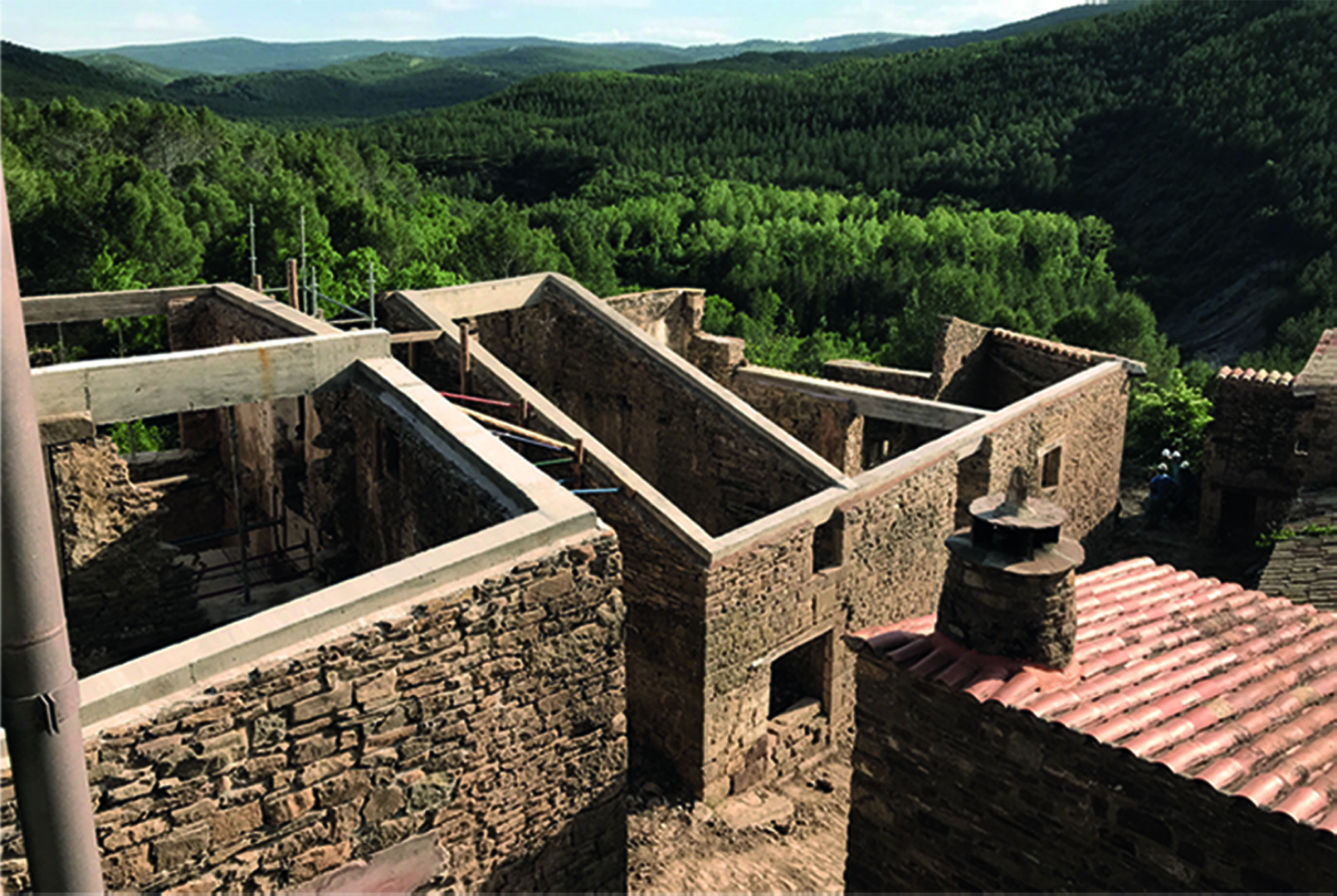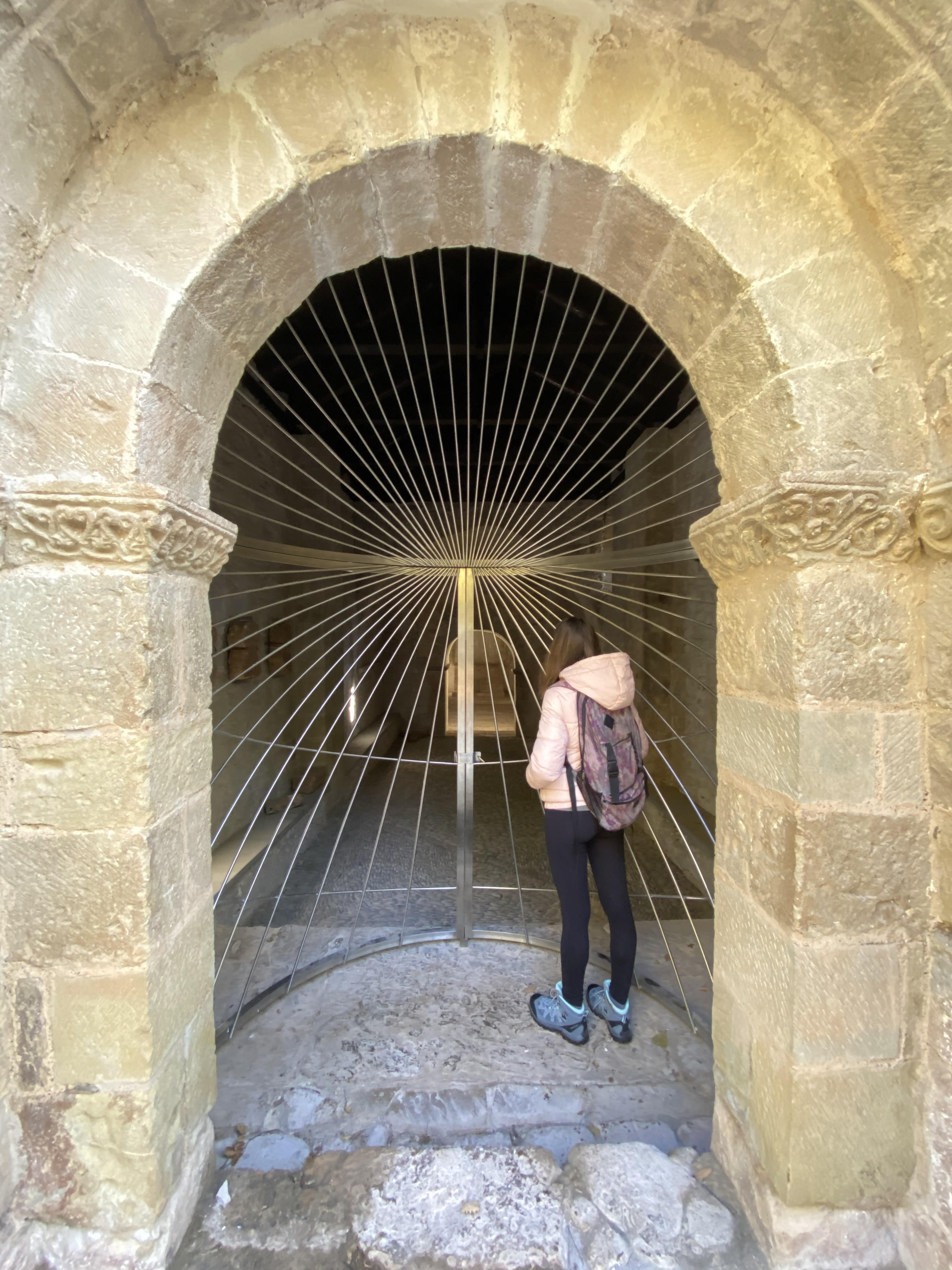Ruesta is a beautiful remain, a testimony of an important history that asks for being preserved. Ruesta makes all who visit it fall in love, and reveals a territorial reality: the uninhabited Spain. The actions carried out have made possible the recovery of the Way as it passes through Ruesta, as well as the rehabilitation and restoration of its heritage. The actuations developed are proposing new ways of inhabiting the Way of St James, as this region vital sustenance.
Ruesta is a testimony of an important history that asks for being preserved. Also, Ruesta reveals a territorial reality: the uninhabited Spain.
The projects carried out propose new ways of inhabiting the fleeting time of a place in the Way of St James, as this region´s main vital sustenance. The works have been executed in an area with an extraordinary heritage, which was in a state of complete abandonment and deterioration. The exceptionality of works done in Ruesta and its surroundings consists in acting in a unique atmosphere, where the intervention has always sought naturalness and minimum impact, but also recognisability, to allow a clear reading between the original elements, and the contemporary elements. All this allows preserving and enhancing the value of the pre-existence.
Since 2017, several interventions have been developed in The Camino's heritage. The actuations have allowed to value and recover the "Camino de Santiago" (Way of St.James) as it passes through the village of Ruesta, as well as the restoration of the downtown, its chapels (San Jacobo and San Juan), and other chapels like San Juan de Sigüés, and Escó.
All the projects have been planned according to two master plans: one for the Pilgrims' Route to Santiago and one for the Recovery of Ruesta, which have taken shape in several execution projects, all of them linked to the Route.
Behind these actuations resides the hope of a territory to revitalize of the Route as a fight against depopulation and as an opportunity of local's heritage preservation.
We hope our efforts will allow the Camino de Santiago to become, once again, a cultural and social backbone in a depopulated territory that puts its hope in the revitalization of this way of exchange, to stop the depopulation, in a region especially affected by this unfortunate phenomenon, but also as a way of conservation, protection, and enhancement of nature, sustainable tourism and local heritage.
Please highlight how the project can be exemplary in this context
As we already stated, the projects have been developed in a depopulated area, where "The Camino" is the only hope of their this territory. Nowadays, the Way goes over a entirely natural area, crossing beautiful natural sceneries, one of the main targets was to remain this beauty, supplementing it with the reparation of lost services, but always looking to achieve it with no impact on the environment.
Other objectives concerned the revitalization of the Way, understood like the possibility to relaunch the municipalities, and as a way to protect and preserve the heritage. That is because all the projects promote self-sustainable uses, minimal investment, self-management and low maintenance requirements.
We even made some designs to enable the "self-use" of some restored buildings. This self-use consisted in designing some doors for chapels to allowed the visits of pilgrims and tourists, but limiting the access to a restricted part of the building. With this easy action we protected the building from vandalism and we avoided a building closed to the public, because, in some cases there doesn´t exist the possibility of a guard or a guide. Furthermore, the works developed to restore the street where The Way transits, enabled to create a camping between the ruins.
All the materials employed in the works were local and nearby products, in some cases, even proceed from the reused stones of the fallen walls, focusing in a low-impact and circular economy and traditional systems, always looking for preservation, protection, enhancement of nature, sustainable tourism and surrounding heritage.
Please highlight how the project can be exemplary in this context
All the actions were projected according to two master plans, so all the executed projects were under the same umbrella: a detailed planning to meet a specific range of values and design parameters.
The exceptionality of acting in Ruesta and its surroundings consists in acting in a unique atmosphere, where the intervention has always sought naturalness and minimum impact, but also recognisability, to allow a clear reading between the original elements, and the contemporary elements. All this allows preserving and enhancing the value of the pre-existence. The intervention eludes the historical fake and presents Ruesta naturally, as it is, like a beautiful ruin, which maintains the elements that define the essence and urban environment that it once had. The first action consisted in consolidating some of the houses in Centre Street, the structural consolidation is designed from the joint work of all building structures, as an organism. The concrete beams make up an upper ring that prevents lateral movements, protects the upper part of the stone walls and, as a souvenir, draws a white line that defines, from the air, the design of the old village of Ruesta. The criteria that would rule over all the interventions are as follows: there is not only a structural intention in the preservation of the ruin, but also an important visual intention. Far from presenting the ruin as a dangerous element, the scaffolding and reinforcement elements help to interpret the urban environment of the old Ruesta with a subtle language. Thus, avoiding the negative visual impact of the diagonal struts, we designed timbers that clear the holes and also serve to recover the image of the window’s old structure of the "Camino”. In Ruesta's San Juan chapel, the reintegration has been carried out with a critical restoration, where the lost volume, of approximately 60%, has been recovered with an abstract and unitary language.
Please highlight how the project can be exemplary in this context
We designed the projects for the recovery of St. James Way thinking about it as an element that should have a universal design, because it is unique and adaptable to everyone, with every life circumstance, because the Way is as diverse as the people who travel it, so, the actuations were planned thinking of universal accessibility, with a pursuit of the paradigm of universal design in the developed works as cultural, natural and heritage environments, in order to be used by the highest possible number of people on equal terms, recovering universal accessibility where it had been lost.
These universal values were also part of the drafting process of the projects, so, while the projects were being developed, we also organized several round tables with citizens, municipalities and administrations to gather a valuable input, and to incorporate their requests into the projects. When designing public spaces, the architectural concept can easily clash with the user's experience. Therefore, engaging the community and future users in the project development and design process is a way of adding different perspectives to the architect's vision towards a more intelligent architecture. Thanks to these round tables, we designed "self-uses" for the recovered buildings, looking for sustainability for the projects over time, both financially and in terms of results and human resources.
But the project also considers public participation after finishing the construction works, because thanks to the digitization, the internet is a tool that promotes greater participation among users in the management and use of space. So, the initial interventions become open projects that give rise to synergies and improve relationships with the public. This happens especially in Ruesta's San Juan Chapel, with the virtual recreation of his wall paintings, but it happens as well in Ruesta's downtown with the digitization of his ruins, and the creation of a 3D model of the village.
Please highlight how this approach can be exemplary
The Way of Saint James is the contact with nature, silence, multicultural exchange and cultural and patrimonial heritage of a route declared World Heritage by UNESCO.
With Way’s recovery in Ruesta, we also proposed some houses in “Centro” Street to be used as an unprecedented archaeological camping area, next to the current pilgrim hostel. With this initiative, the restorations works become in a realistic alternative to the phenomenon of depopulation in Spain, following the model of “diffuse hotel” as a form of tourist accommodation, where the rooms are distributed in several buildings provided with a general reception in the current hostel, we called it “Ruesting”. This idea was developed with the hostel’s management collaboration, as an opportunity for reinsertion of unemployed people, in search for new vital opportunities.
In the chapels’ designs, which are isolated in the middle of the nature, we designed self-services initiatives, supported by the current hostel’s reception. Once you arrive to Ruesta you will be able to visit by yourself thanks of the design of the doors’ geometry which allow a self-musealisation of the spaces. The initiative consists in a limited open access area; from there, you will be able to visit the monument and a virtual restoration of the chapel’s primitive appearance with your own smartphone, and this recreation has been developed in collaboration with University of Zaragoza.
The collaboration has been a constant in all the works: between national, regional, and local administrations, as well the dialogue between municipalities and their citizens has been a key theme in the Master’s Plan elaboration, which, after all, guided the following actuations. Behind these actions lays hope of territory to revive the Way in a struggle against depopulation and as an opportunity for local's heritage preservation.
Given the large number of factors to be considered, the process of intervention has been particularly complex, but enormously fruitful in terms of transversal assessments of all the subjects of study, since the breadth of visions has allowed conclusions to be drawn in an effective and almost direct way, based on the interrelation of disciplines. This useful general vision, which contemplates both the being and the becoming of it, has drawn up a complete diagnostic assessment of the whole, which has allowed us to point out clear lines of action.
The main objective was the Way of St. James’ recovery. With his restoration we recovered the Way’s continuity between Europe and Spain, and we achieved a great result: the Pilgrims’ continuity to Santiago de Compostela, but the complementary achievements were important as well.
With the recovery of the physical route we got an intangible asset, with a millenary history, and with a build environment as well. The works were a key step to resolve the village’s need of regeneration, and the Way as an opportunity to do so. Finally we would like to highlight the implementation of new employments thanks to Sustainable Tourism’s initiatives (like archaeological camping) and thanks to courses developed in the area, as a collaboration between University of Zaragoza and Ebro’s Hydrographic Confederation.
Please also explain the benefits that derived from their involvement.
The actions carried out allow pilgrims and tourists to safely return to enjoy the exciting experience of walking the Way of St. James, so the whole of society has benefited from the restoration of the Way, also giving it new uses, a new life, a new opportunity.
From the very beginning there has been collaboration and joint financing between several administrations and institutions: from the CGT union (current concessionaire of the use of Ruesta), the Ebro Hydrographic Confederation (CHE), Aragon Government (departments of Heritage, Tourism and Territory), local councils (Urriés, Sigüés, Los Pintanos) and other organisations in the area, such as the Pyrenean Institute of Ecology, the Association of Friends of the Way of St. James or the Association of Municipalities of the Way of St. James. We participated in the organization of several round tables, where citizens and organizations were invited to incorporate their requests into the projects. Thanks to the established dialogue, we designed the mentioned "self-uses" for the recovered buildings, in search of long-lasting sustainability. One of the main concerns in the round tables was to obtain an alternative for the future, for the depopulation in the region. The recovery of equipments, designs for “self-uses” and restoration works in the Way, were the main tasks to achieve that objective. After that, the efforts have continued with collaborative workshops with the university of Zaragoza, municipal courses, etc.
As a result, we can say that the involvement of citizens has been for their own good, to achieve the initial objectives.
The main global challenge was to give continuity to the largest cultural route in Europe, between France and Spain, at a point where the connection had been lost. And we achieved that by restoring a specific path fragment that reconnected the two parts of the Way of Saint James in Ruesta.
But other global challenges also guided the actions, such as low carbon footprint, integration with nature, low impact, and sustainable tourism. Basing the projects in these values, all the materials employed in the construction works were local and nearby products, in some cases, employing stones from the fallen walls, focusing in a low-impact and circular economy as well as traditional systems, looking for preservation, protection, and a enhancement of nature, sustainable tourism and local heritage. We also considered the aforementioned values in our designs, which meant a search for mimesis with nature and with protected environments (natural and built).
The most important local material of the project was already there, it was Ruesta and its atmosphere, and environment and nature have been the most important inputs of the project, we just had to place value on its natural and built environment.
The interventions were guided by our Master plan. It was focused on understanding of the complex, mapping, documentation, analysis and diagnosis of the current state, and finally, intervention projects. To this end, an innovative methodology was applied and developed in three phases:
-Data collection: to carry it out, we have developed an intense data collection in situ with drone flight, digitization, 3d models, etc
-Analysis and Diagnosis: investigating the configuration of spaces and their evolution, material and construction pathologies, deficiencies to be rectified, the state and functioning of general services, as well as the needs of the future programme.
-Intervention Projects: Maintenance and management plans to correct pathologies and constructive and functional deficiencies, recover and/or enhance elements of interest and their spatial configuration, as well as propose new uses. In this last phase, all the previous development has been included.
As part of these projects, we designed the innovative concept of "self-musealisation" for its interior, since the presence of a person is not necessary for guiding a visit or for selling a ticket. An innovative character was also developed in San Juan's chapel for the construction works; using CNC to manufacture the shape designed for its façade stones. The CNC system is the automated control of machining tools by means of a computer, where a machine processed the pieces of stone to meet specifications by following coded programmed instructions. In the chapel, once the pilgrims have passed through the land art installation designed by our team (a landscape of stones for reflection on the lost history of the heritage), they can go inside, where it is possible to contemplate a virtual recreation of the original Romanesque paintings. This recreation uses the technique of augmented reality and through the camera of any smartphone you can see the paintings in the position where they were originally.
Please provide clear documentation, communication of methodology and principles in this context.
We think the idea of revitalizing a depopulated region through cultural elements such as the Way of Saint James, is the main potential of the project and it is transferable as well. Throughout Europe we can find similar regions, with a lot of cultural and natural, tangible and intangible heritage, but unfortunately suffering the process of depopulation. The experience and know-how we have gathered on this project can be implemented in similar endeavour where sustainable, low impact and community-oriented goals are to be achieved.
The main element that makes it all possible is the Way of St. James, an intangible asset, with a millenary history. We can say the Way is the history of a dynamic and constant change throughout history, but the current route in Ruesta was a degraded route that offers an arduous image of the Way; and the Way’s restoration has been the opportunity to do so.
The interventions carried out have been a challenge and an opportunity. It was a challenge, because of natural integration in the landscape. And an opportunity, for finding a new language that, without confrontation, gets the objective from a clear reading of “reconoscibilità” and “reversibilità” (readability, recognisability and reversibility), avoiding historical fakes.
The intervention process has been particularly complex, but enormously fruitful in terms of transversal assessments of all the themes of study, since the breadth of visions has allowed conclusions to be drawn in an effective and almost direct way, based on the interrelation of disciplines. This useful general vision, which contemplates the being and the becoming of it, has drawn up a complete diagnostic assessment of the whole, which has allowed us to point out clear lines of action.
So we can conclude that one of the most important (and transferable) factors has been the creation of a master plan that has guided all the actions, from the preliminary studies with a list of objectives to the execution projects.






@SEBASTIAN ARQUTECTOS SLP, 2021
Content licensed to the European Union.